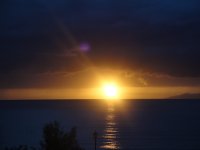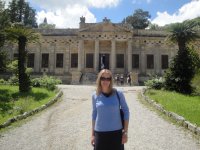Exploring Napoleon’s Empire: Elba
 As a history buff, Elba has always been the place I associated with Napoleon’s short exile, but I’d never visited Italy’s third largest island until I received a wedding invitation.
As a history buff, Elba has always been the place I associated with Napoleon’s short exile, but I’d never visited Italy’s third largest island until I received a wedding invitation.
The weather was touch and go on this Tuscan island during our visit earlier this month. It was definitely too cold and windy to enjoy swimming in its blue waters, but it was a nice opportunity to explore the island – especially when the sun broke through those pesky grey clouds.
Elba is remarkably green and lush (especially when compared to the interior of Italy’s two largest islands: Sicily and Sardinia). Elba is a popular place for hikers and mountain bikers, with a network of well-marked trails scattered throughout the island. We didn’t have time to explore them on this visit, but look forward to next time.
 The island can be reached by a 50-minute ferry ride from the Tuscan coastal town of Piombino, with frequent ferries carrying passengers and their cars across to the Elban port town of Portoferraio.
The island can be reached by a 50-minute ferry ride from the Tuscan coastal town of Piombino, with frequent ferries carrying passengers and their cars across to the Elban port town of Portoferraio.
‘Ferro’ means iron in Italian, and this island was once famous for its iron deposits. Portoferraio had important iron and steel factories through World War II. Today, the island’s economy is mainly concentrated on tourism. The roads are good, but narrow and winding, and having a car is important to be able to explore.
Here are some highlights to see during your visit to Elba:
 Portoferraio – This is Elba’s largest city and capital. Ferries from Piombino, on the mainland, arrive here, so this is often the first port of call for visitors to Elba. The impressive fortifications make for a wonderful first view of the city. The fortifications in their present state were built under the rule of Cosimo I de’ Medici, the Grand Duke of Tuscany, in 1548.
Portoferraio – This is Elba’s largest city and capital. Ferries from Piombino, on the mainland, arrive here, so this is often the first port of call for visitors to Elba. The impressive fortifications make for a wonderful first view of the city. The fortifications in their present state were built under the rule of Cosimo I de’ Medici, the Grand Duke of Tuscany, in 1548.
The city grew rapidly in the 19th century, with the establishment of iron mines. The port city became the main hub for shipping the mined iron to the mainland, and it prospered in this period. It’s a fun city to explore, with its steep, cobblestoned streets, colorful houses, and impressive views over the port and the sea.
 Marciana marina- This little seaside town first showed up on a map in 1420, although the town in its current state began taking shape in the late 16th century. By the late 18th century, the town was an important port and commercial city. The town church, Santa Chiara, was built in 1776.
Marciana marina- This little seaside town first showed up on a map in 1420, although the town in its current state began taking shape in the late 16th century. By the late 18th century, the town was an important port and commercial city. The town church, Santa Chiara, was built in 1776.
On the road leading to the neighboring town of Procchio, you can see a little island that’s called La Paolina. This is in honor of Napoleon’s beautiful sister, Paolina Bonaparte (Borghese), the only sister who accompanied him in exile. During her time in Elba, she is said to have favored the beach along the mainland facing this island for sunbathing.
Who knew porcelain-skinned ladies sunbathed back in 1814? Of course, this is the same woman who was known for having dozens of lovers (even her brother had learned not to try to control her behavior, despite his frustrations), and having posed nude for Canova’s Victorious Venus, the sensuous sculpture now housed in Rome’s Borghese Gallery (the legend goes, it was such a perfect likeness and it drew so much – ahem -attention and admiration from visitors, that her husband refused to keep it on display for guests), so I suppose she was a woman who knew a thing or two about flaunting the rules.
 San Martino (Napoleon’s villa) – Napoleon Bonaparte was, for a short time, Elba’s most famous resident. The Treaty of Fointainebleau, signed on 11 April 1814, allowed Napoleon to retain his title of Emperor – over the island of 12,000 inhabitants at the time. He lived in this villa in San Martino, surrounded by green hills and with a spectacular view out to Portoferraio.
San Martino (Napoleon’s villa) – Napoleon Bonaparte was, for a short time, Elba’s most famous resident. The Treaty of Fointainebleau, signed on 11 April 1814, allowed Napoleon to retain his title of Emperor – over the island of 12,000 inhabitants at the time. He lived in this villa in San Martino, surrounded by green hills and with a spectacular view out to Portoferraio.
By all accounts, he was quite active in developing Elba’s economy during his short stay – both modernizing agriculture, and encouraging development of the iron mines.
You can visit the original villa and the segment added later, in the 1850s, which contains interesting political cartoons and vignettes of Napoleon, showing how he was revered and feared throughout Europe.
This idyllic scenario didn’t last long. Napoleon escaped from Elba on 26 February 1815, and made his way to the French shore.
His his defeat in the Battle of Waterloo sent him on his second – and last- exile, to the remote Atlantic Ocean island of Saint Helena in October 1815, where he died in 1821. I’m guessing San Martino in Elba must have been looking pretty good from that remote outpost.
That should get you started on Elba, but there’s more to see. I’ll continue my Elba tips in next week’s post.


Elba looks great, I’ve always wanted to visit.
I went to Elba once and I still wear the pair of earrings I bought there. We also had rotten weather and I was pushing a pram I recall!
I’m sure you’ll enjoy it, Grace! Hi Catherine – ha, you saw it in rainy/grey weather, too? At least the sun broke out every once in a while during our stay (I’ve become way too Italian). : )
[…] week I wrote a post about what to see and do on the interesting Tuscan island of Elba, including a visit to the home […]
[…] For more travel tips around Tuscany, see my earlier posts on the imposing castle of Radicofani, visiting medieval Sarteano, views from the top of the volcano-mountain Monte Amiata, relaxing in the thermal baths of San Filippo ai bagni, and exploring Napoleon’s Empire: the island of Elba. […]